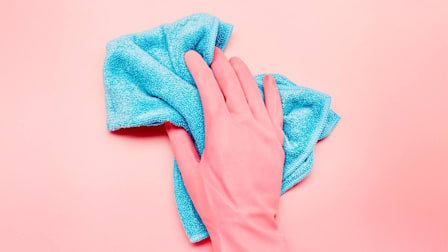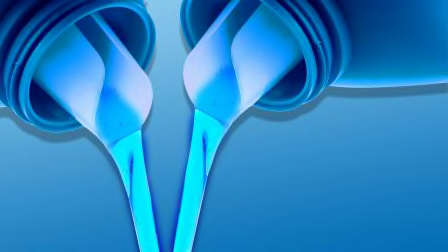The Ultimate Stain-Removal Guide
How to tackle spills and spots fast—from coffee, tea, and wine to mustard, tomato sauce, and more
When you shop through retailer links on our site, we may earn affiliate commissions. 100% of the fees we collect are used to support our nonprofit mission. Learn more.
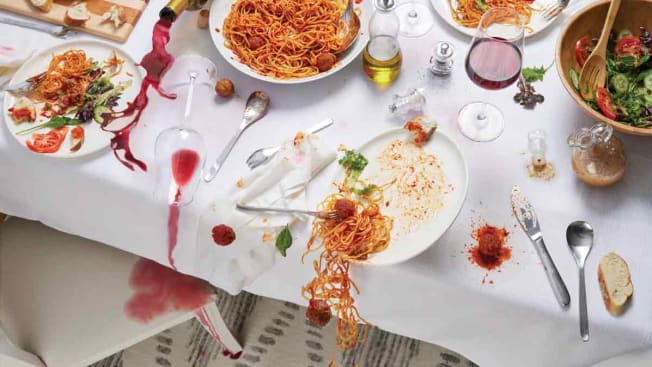
Household accidents may be inevitable—food and drinks will spill, pets can have accidents—but they don’t have to leave behind permanent marks on your furniture, counters, floors, and more.
"With a little know-how and patience, you can remove most stains yourself," says Brian Sansoni, senior vice president at the American Cleaning Institute. "The key is to act quickly and have the right cleaning products on hand."
Ground Rules for Dealing With Stains
To help you keep your home and clothes stain-free, we’ve gathered the smartest, simplest stain-removal advice and tools to tackle common offenders, starting with food spills. First, some ground rules:
Act quickly. Follow the appropriate steps ASAP to keep the stain from setting.
And do this first. Use a cotton swab to test a small, out-of-the-way spot to see how it handles a stain remover. If you note fading or other damage, you may need professional help—a dry cleaner or carpet or upholstery cleaning service.
Keep These Products on Hand at Home
Coffee/Tea/Wine
These beverages started as plants and get their stain power from vegetable dyes.
Washable fabrics: Work from the back of the fabric, flushing it with cold water, then apply an enzymatic laundry pretreat (see the CR Quick Take, below, for a top-rated choice) and wait a few minutes. Rub a little laundry detergent into the stain and launder. If needed, repeat the pretreat-detergent-launder process.
Upholstery: Blot like crazy, then splash with carbonated water; blot and repeat. No luck? Dampen with water, apply cleaning solution, work it in with a clean sponge, and blot. Repeat until clean. Dab with water to remove detergent, and blot.
Leather: Blot with a damp cloth as soon as possible.
Carpet: Blot well. Mix 4 cups of water, a tablespoon of dish soap, and a quarter-cup of white vinegar, and apply with a clean sponge, soaking the spot. After 5 to 10 minutes, blot again with a clean cloth. If the stain remains, try a commercial product such as Folex Instant Carpet Spot Remover—or call in a professional. Read more about dealing with carpet stains.
Natural stone countertops: For granite, soapstone, and quartz, make a baking soda paste (see "Ground Rules for Dealing With Stains," above), apply to the spot, and cover with plastic wrap for a day to keep it moist. Next, peel away the wrap, let the paste soak up the stain for another day, then wipe away.
The technique is slightly different for marble, travertine, and limestone. Acidic substances such as coffee, tea, wine, and fruit juice will etch the stone, creating a stained appearance—even a fruity ice pop can cause damage, according to Clark Lovrien, general manager of Dalworth Clean, a cleaning service in the Dallas-Fort Worth area. You can try the baking soda paste; this may also work for rust stains. Or place paper towels soaked in bleach on the area for 24 hours, then rinse with water. A commercial marble-polishing product, like Weiman Quartz & Stone Clean & Shine or Zep Granite and Stone Cleaner & Protectant, may also help.
Laminate countertops: Spread a baking soda paste over the stain, let it sit for 5 minutes, then wipe with a damp microfiber cloth (never scrub with an abrasive). Stain still there? Contact the manufacturer for help.
Non-wood flooring: Rub gently with scouring powder and a cloth dampened in hot water—or dab with 3 percent hydrogen peroxide.
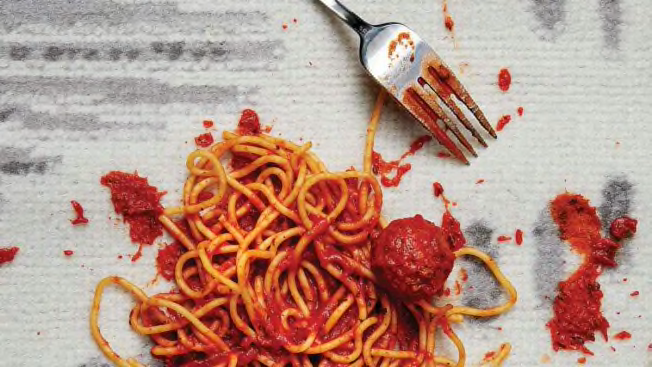
Photo: Ben Goldstein Photo: Ben Goldstein
Ketchup/Tomato Sauce
These foods are often doubly challenging, says Kathlyn Swantko, president of the consumer textile information resource FabricLink, because tomatoes’ red pigment acts as a dye and any oil (in, say, pasta sauce) tends to saturate and stick to fabric fibers.
Carpet: Blot, or scrape with a butter knife to remove excess, then saturate the stain with ammonia solution (1 tablespoon of clear household ammonia to ½ cup of water) from a spray bottle; blot well. Next, apply a bit of cleaning solution (see "Ground Rules for Dealing With Stains," above); blot well. Spritz the area with water, and blot. Spray it again, then cover with a pad of paper or cloth towels under a weight to dry. (Got a brick? Perfect.)
Washable fabrics: Saturate the area with an enzymatic laundry pretreatment, such as OxiClean MaxForce Spray (see above) for the amount of time noted on the bottle. If it’s a large stain, rub in liquid laundry detergent, then wash in cold water. Repeat if necessary before drying to avoid setting the stain.
Upholstery: Blot to remove excess. Wet fabric with a small amount of water, soak for 1 minute, and blot with paper towel. Repeat until the stain is gone; blot dry. Stain still there? Dampen the area, use a sponge to work a small amount of your cleaning solution (¼ teaspoon dishwashing liquid to 1 cup of warm water) into the stain, and blot until it’s gone. Blot with cold water and dab dry.
Leather: This is a tricky one. You can try the same approach as for mustard, below, or ask your furniture dealer or dry cleaner for advice.
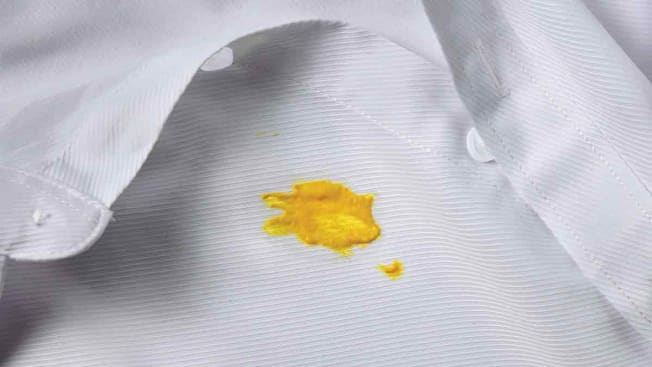
Photo: Ben Goldstein Photo: Ben Goldstein
Mustard
Turmeric, the spice in mustard, curries, and many other foods, contains curcumin, which gives the seasoning its hue. The problem: Curcumin is not water-soluble, so it’s a challenge to remove.
Washable fabrics, upholstery, and carpet: Scrape off the condiment first. Mix up a cleaning solution (¼ teaspoon dishwashing liquid to 1 cup of warm water) and work into the fabric, rinse well, and dry the item in the sun. (Curcumin is very sensitive to sunlight—nature’s bleaching agent.) Another method for washable fabrics: Flush with cold water, apply an enzymatic pretreat, then launder with color-safe bleach, used as directed.
Leather: Mix a solution of mild soap (such as Ivory) in lukewarm water, swishing it to create suds. Apply only the suds to a sponge and wipe the area. Wipe again, with a clean cloth dampened with clear water. Dry with a soft cloth, then follow with an application of a commercial leather conditioner.
Non-wood flooring: Remove as much as you can with a cleaning solution (see “Washable fabrics, upholstery, and carpet,” above). If possible, let sunlight into the area for one to two days to help fade the stain. No sun? Blotting with 3 percent hydrogen peroxide may also help.
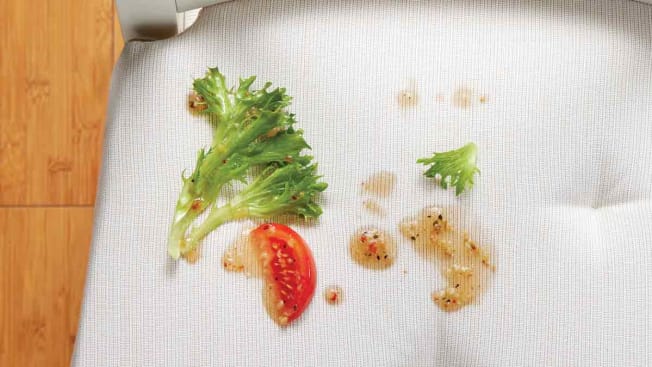
Photo: Ben Goldstein Photo: Ben Goldstein
Oil/Food Grease/Salad Dressing
Oil-based stains are notoriously challenging—in part because oil and water don’t mix. So simply rinsing won’t work. Be sure to avoid heat (hot water, the dryer), which locks in these stains. The techniques here are also good for mayo, butter, and body lotion.
Washable fabrics: Blot, then use an enzymatic laundry pretreat, such as OxiClean MaxForce Spray (see above), as directed on the label. Rub in a dab of laundry detergent with your fingertip; launder in cold water. Repeat steps as needed before drying.
Upholstery: If you’re dealing with a dollop of Alfredo sauce or other oil-based substance, first check the fabric care label to make sure you can use liquids. Then blot up any excess moisture with a clean cloth and spray the area with an upholstery cleaner. (One to try: Resolve Upholstery & Multi-Fabric Spot & Stain Remover.) Blot again with a clean, damp cloth. Rinse the cloth and repeat if necessary. You may want to call in a pro.
Leather: An oil-based stain is likely to be absorbed by leather. You can try this method: Blot with a clean, dry cloth, then cover the area with a thin layer of baking soda and leave it in place for a couple of hours, then wipe it away with a fresh cloth. A commercial leather degreaser can be helpful, too. If the spot remains after those efforts, you may need to seek help from a professional upholstery cleaning service.
Carpet: Apply a small amount of dish detergent to the spot with a cloth, then blot dry. If that doesn’t work, dab on a small amount of dry-cleaning solvent with a fresh cloth. Blot, then rinse. Not gone? Sprinkle on baking soda; vacuum once it has absorbed the stain.
Natural stone countertops (such as granite and marble, but not nonporous quartz): In a small bowl, add baking soda to 1 to 2 tablespoons of acetone-based nail polish remover until it’s the consistency of pancake batter, cover the spot with the mixture, and let it sit overnight. The acetone breaks down the oil, and the baking soda absorbs it. Repeat as necessary.
Wood furniture: While wood that’s well sealed shouldn’t stain easily, mishaps do happen—like letting a dripping bottle of salad dressing sit on your dining table overnight. In those situations, apply a baking soda paste over the area. Leave it in place for a few hours, then wipe away. That will often lift the stain. Otherwise, try rubbing it with a cloth and your cleaning solution, then follow up with a wood polish such as Howard Feed-N-Wax Wood Polish & Conditioner. No luck? Look into refinishing.
Blood
Blood is a protein stain—add heat and it can become permanent. The key to getting this tough stuff out? “Cold water and speed,” Swantko says.
Washable fabrics: Flush with cold water, then spray with enzymatic laundry pretreat, such as OxiClean MaxForce Spray (see above). Once that has had a chance to work, massage a little laundry detergent into the spot; launder in cold water.
Upholstery: Blot to remove excess blood. Wet fabric with a minimum amount of water, wait 1 minute, then blot with paper towel. Repeat water/blot procedure until no stain shows on towel; blot dry.
Leather: Mix a solution of mild soap (such as Ivory) in cool water. Swish it around to create suds. Apply only the foam with a clean sponge, gently rubbing, taking care not to spread the stain. Wipe the area dry with a clean, soft cloth.
Carpet: Apply a small amount of cold water to the stain as quickly as possible and blot the area with a cotton cloth. Repeat until the stain is gone.
Makeup
Makeup’s long-lasting pigments (from minerals, dyes, and colorants) and skin-moisturizing emollients make it tough to remove.
Washable fabrics: Blot with acetone-based nail polish remover, then try a store-bought cleaning solvent, such as Alba or Goo Gone. For lipstick, put the stained fabric on top of a few sheets of white paper towel or microfiber cloth, and blot repeatedly with acetone-based nail polish remover or rubbing alcohol to lift off as much as you can. If the stain remains, try a commercial product, like Carbona Stain Devils #6.
Upholstery and carpet: Blot to remove excess. Dab the spot with a small amount of rubbing alcohol and blot dry immediately. When working on upholstery, be careful not to wet the fabric or you may wind up with a water mark. When addressing a potential stain on carpet, be careful not to totally soak through with alcohol; it can damage the latex backing. (Check out CR’s best carpet cleaners.)
Leather: See “Oil/Food Grease/Salad Dressing,” above, because these are typically oil-based stains.
Non-wood flooring: Wipe up as much as you can with a paper towel first, then use fine steel wool with all-purpose detergent and water. For a no-wax finish or embossed vinyl flooring, use a plastic scouring pad instead of steel wool.
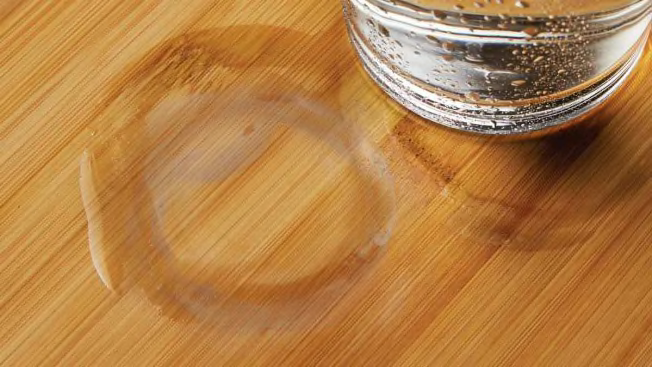
Photo: Ben Goldstein Photo: Ben Goldstein
Water Rings
These are typically made by a wet glass left on a wood surface. If the stain remains after taking the steps here, you may have to refinish the wood surface.
Wood surfaces: Blot with a paper towel or cloth, wipe with a damp cloth, and dry with a soft cloth. Still see that ring? In the direction of the wood grain, rub in a small dab of non-gel toothpaste or a liquid or cream car polish. Wipe with a clean, dry cloth, and polish if desired. Or, say the experts at Molly Maid cleaning service, put a layer of regular mayonnaise (which contains no less than 65 percent vegetable oil by weight vs. reduced-fat products) over the ring, let it sit overnight, and wipe clean in the morning.
Pet Accidents
Pet messes typically happen on the floor. Here’s what to do for carpet, which tends to soak up whatever lands on it.
Carpet: Scrape away hardened poop and blot the remaining stain or area where your pet urinated. Then use an enzymatic pet-stain cleaner as directed. (Nature’s Miracle makes formulas for cats and dogs.)
If you don’t have a cleaner on hand, wet paper towels with your cleaning solution (¼ teaspoon dishwashing liquid to 1 cup of warm water) and blot repeatedly to wick away the stain; wet the area with warm water between applications. Repeat as needed. Next, mix 1 cup white vinegar in 2 cups water, apply to the area, and blot dry. Stack some white paper towels on top, weighed down with a heavy object that won’t transfer color. Change the paper towels as needed to dry.
Stains That Really Stick
“There are a couple of stains that fall into the ‘good luck getting it out’ category,” says Tom Swantko, content director at FabricLink. They are permanent ink and hair dye, which are made to add intense color and stay put. You can try specially formulated products (“there are dye strippers on the market,” Swantko says), but you may also remove the original color of the fabric or surface. Consult a dry cleaner or upholstery cleaner—and don’t expect success.
@consumerreports Skip the stain remover 👌. Do you have a laundry question? Share it in the comments and we may answer it in a future video! #cleantok #laundrytok #laundryday ♬ original sound - Consumer Reports
Editor’s Note: This article also appeared in the May/June 2025 issue of Consumer Reports magazine.

















